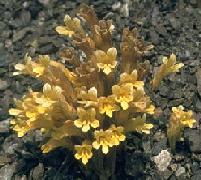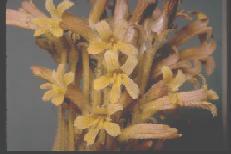
Cal Flora

Cal Flora
Clustered Broomrape
Orobanch fasciculata Nutt.
The Clustered Broomrape is a perennial herb that grows about 6 to 11 inches in height. Its thick and fleshy stems are clustered with small, scale-like leaves. The flowers are solitary on numerous stalks above short, scaly stems with tubes of 1 to 1 1/2 inches and sepals that re 5 parted, triangular, usually shorter than flower the flower tube. The petals are yellow, tinged with purple, 2 lipped, upper with 2 lobes, lower with 3; and stamens, 2 pairs, inside foral tubes. Sticky, glandular hairs cover the the yellow to purplish stems, leaves and flowers. The petals are fused into a slightly arched tube with five lobes. The root is fleshy and bulbous. The leaves are reduced to alternate scales, without chlorophyll. The plant depends upon associated plants for food, nutrients, and water; it's part of a family of root parasites. It is in bloom from April to July. It is located in shad scale, sagebrush, and pinyin-juniper vegetation from 1200-1300 mountain elevations and is found throughout the Intermountain area.
Food use:
The entire plant is edible, either raw or cooked. The plant
can be boiled in ashes then peeled and eaten like potatoes.
Medicine:
The root is pectoral. The chewed root has been used as a
dressing on wounds and open sores. An infusion of the leaves is used as a
wash on sores. Forms of the plant that are parasitic on sweet sage roots have
been used as a treatment of cancer. The dried and powdered plant is inserted in
the rectum as a specific treatment for hemorrhoids.

From Cal Flora